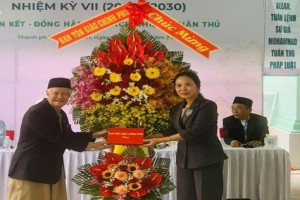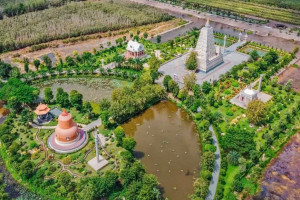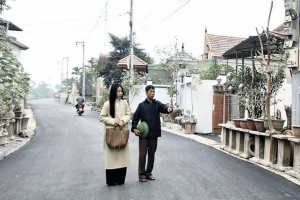
Imprints of Theravada Buddhism in the cultural and spiritual tradition of Khmer people in Mekong Delta
09/17/2014
Most of Khmer people living in the Mekong Delta follow Theravada Buddhism. This religion still has profound effects on many aspects to life and become an internal structure contributing to create cultural identities of the Khmer people.
Therefore, the study of traditional culture of the Khmer should be necessarily put it in an intimate relationship with Theravada Buddhism.
With nearly 1.3 million people, mostly living the South West region, Khmer people has the highest number of South Asian linguistic group in Vietnam and is the second largest ethnic group in the South West region, just after the Kinh. Khmers accounts for 30% of the provincial population of Tra Vinh, 29% of that of Soc Trang with approximately 354,000 persons, and 13% of Kien Giang’s population. The Khmer people is also an ethnic tribe residing in the Mekong Delta very early.
Vietnam is a multi-ethnic and multi-religious country, and religons and peoples in Vietnam contributed to form a cohesive and diverse culture of Vietnam.
Khmer people, although influenced by the culture of other ethnic groups, still retain and promote their cultural identity. What makes typical "cultural identity" of ethnic Khmers is in part Theravada Buddhism. The core values of Theravada Buddhism has blended into, and become the soul of this culture, as shown in the followings:
1. Imprints of Theravada Buddhism in traditional festivals of the Khmer
The traditional festival holds a very important place in the social life of the nation in general, the Khmer people in the Mekong River delta in particular. It is the aggregation of cultural characters of a people or a community. When researching traditional festivals of the Khmer people, it’ easy to point out clear imprints of Theravada Buddhism. First and formost, most of festivals of the Khmer people, including traditional festivals and Buddhist ones, were attached to Buddhist temples, often taking place in the temples and presided over by abbot monks. The traditional festivals were blended with Buddhist rituals. The festival is characterized by the influence of religious beliefs and Buddhist rites.
Imprints of Theravada Buddhism are manifested not only in outward signs but also in the content of the festival, making the traditional festival more meaningfull. The festivals are often associated with a story, legend or an event relating to Theravada Buddhism, creating a rich spiritual consciousness.
Khmer people in the
Apart from Buddhist festivals, folk festivals (also known as "Pithi") such as the New Year celebration, death anniversaries of ancestors, water festival, moon festival, boat-race festival ... show deep imprints of Buddhism. Therefore, we can say, most of the Khmer festivals are religious festivities, wherever they originate from.
2. Imprints of Theravada Buddhism in the custom and practice of the Khmer
Not only does Theravada Buddhism leave deep imprints in the traditional festivals, it also has a profound impact on customs and habits of the people. These customs and traditions are still preserved and become beautiful traits of the Khmer culture, as expressed in the followings:
Taking a religious life: in Khmer perspective, monkhood is not only a purely religious activity but also a tradition, a long-standing cultural nuance. Monkhood is an important stage of life and a criterion for evaluating moral and cultural characters of each person. Khmer people have a saying: "The one unable to take a religious life in the pagoda has many sins in life". So Khmer sons considered eligible and virtuous must have spent some time for self-learning and self- praciticing in a pagoda (1). Khmer people go to temple voluntary and regard it as a noble work. We can say, every Khmer in Mekong Delta region, regardless of wealth and social status since birth, is automatically considered as a Buddhist believer, brought up and taught with Buddhist beliefs and ethics. So, taking a Buddhist life does not necessarily means to become Buddha, but to take an opportunity for learning and practicing so as to become a good person. It’s also a blessing for the parents, families and the men themselves and good ways of expressing gratitude to the parents. Khmer people say that to take a life as a Bhikkhu would return debt of gratitude to the father, while a life as a sadi (religious novice) would return debt of gratitude to the mother. Khmer people understand that in one’s lifetime a man must be a monk at least once and this is the duty and honor for Khmer men.
Beside those Khmer sons going to live a religious life in temples, Khmer people all look forward to the Buddha and practice Buddhist teachings of self-observing of precepts, offerings and Buddhist recitation or changting (eg, Bhikkhu, age 21 or older, observing 4 disciplines and 227 precepts; a Sadi, age 20 or younger, observing 10 principles and 20 precepts; and a Buddhist observing 5 precepts).
Funeral: This is a Khmer tradition greatly influenced by Buddhism. The Khmer funeral is closely associated with the concept of mortality held by Buddhists. In the cycle of life, there are Buddhist blessing at birth, monkhood in adulthood and requiem when passing away. In particular, the dead are cremated, and its remains are put into the tower in the temple with Buddhist rituals. So, the life of the Khmer people is closely attached to the temple and follows a life philosophy "sending the body (to the temple) when living, sending its remains (to the temple) when passing away".
Thus, from festivals to customs and traditions, from weddings, funerals and other activities in the community, there are deep imprints of the Buddhist temple and Buddhist monks. The temple and its monk team have become one of the dominant forces in the existence and direction for the development of the Khmer community. Theravada Buddhism has become an organic part, contributed to the formation of core values of the traditional culture of the Khmer people, and on the other hand, it is also the institution not only to perform purely religious functions but also to support the cultural and traditional values.
3. Imprints of Theravada Buddhism in Khmer lifestyle
Lifestyle is the realization of cultural values through activities of human life. Therefore, the study of imprints of Theravada Buddhism in the traditional culture of the Khmer could not be carried out without studying their lifestyle. Right in this lifestyle we can see the most vivid and closest expressions of Theravada Buddhism. Theravada Buddhism has not only left great impacts on perceptions of life, but also had its mark in the code of conduct between man with nature, community and himself.
The great majority of men spent a certain time in temples, so when returning to the community life they were also carrying values of Buddhism into daily life, contributing to the formation of a own lifestyle of the ethnic Khmer.
Historically, Khmer community doesnot have many wealthy households. One of the causes of this reality is that Khmer people highly regard spiritual values. They can sastifactorily accept certain difficulties as long as their mind is not tainted by temptations of money and physical materials. So, they are easy to share and sympathize with the poor. They save money and offer a majority of this saving money to the temple. Even in the weddings of their children, after paying expenses, they also bring a part of donated money and property to the temples in order to raise merit for the next life. Many families despite facing with many difficulties still devote themselves to Buddhism and make offerings to monks and contributions to building and upgrading of temples. Everybody join hands to shoulder the construction or repair of temples without passing the burden to other individuals. Who has more contributes more, who has less contributes less. So a Khmer house is often simple with little furniture, but a Khmer temple always looks massive, majestic and splendid as Khmer people regard it as their great family. This suggests a human philosophy and a lifestyle imprinted with vestiges of Theravada Buddhism, which is less subject to the effects of the market economy. Also due to this lifestyle Khmer people in Mekong Delta do not like competition to get rich. On the contrary, they are usually happy, quiet and disengaged with realities. They believe that only chosen and blessed ones can get rich, so they are less attentive to changing lives. It is a fact that makes difficult for Khmer people to adapt to the market economy despite great efforts by the Party and State to enhance all aspects of life of the people.
Deeply influenced by the Theravada Buddhist philosophy, in life, the Khmer are always conscious of supporting and helping each other in every way. The mutual support, including sharing of food or clothing amongst fellow Buddhists and making offerings to the Buddhas, are not regarded as life’s burden. On the contrary, it is a moral, a lifestyle and the way to achieve salvation for the next life. Practically, it is a very good value that the market economy hasnot broken it, so it is important for the society to nurture the preservation of this value.
Also deeply influenced by Buddhism, the Khmer in Mekong Delta is very humane and peaceful. They are residents of simplicity, naive, endurance and tolerance, with the desire to achieve a peaceful and harmonious life. Human philosophies of Buddhism - doing good deeds and avoiding evil ones - has become a way of life of the whole community its history and is still valuable assets of the Khmer in Mekong Delta.
In social interaction, the Khmer very humble and polite because they believe that all types of sentient beings have the same Buddha’s nature which should be respected and treated equally. Khmer community’s lifestyle is quiet and discreet, open but not flippant ... After all, these features have been brought by life circumstances with Buddhism as a factor.
It can be said that, Khmer Theravada Buddhism has a position irreplaceable, or at least not yet replaced, in people’s life. The imprint of Buddhism is profound not only in the personal life in the life cycle of birth, aging and sickness, but also in morale and lifestyle of the community. It is one of the pillars contributing to form, retain and preserve the cultural values of the ethnic community over the historical periods and is still effective in the development of Khmer ethnic community in
To avoid misunderstandings it should be emphasized that in human history, a culture despite maybe recognized as rich and energistic but by no means was perfect. Khmer culture with Buddhism as one of its pillars is not an exception. A culture however advanced still needs to be added for self-enrichment. Therefore, refining, preserving, promoting the essence, and filtering out unsuitable factors is not just the development law of every culture, but also the eternal rule.So, promoting practical values and filtering out unsuitable elements is the path of development. Though the road was tough, development can be achieved through life activities and cultural exchanges between peoples. That road, you could say, is wide open by the process of globalization and international integration powerfully and profoundly taking place that a nation can not help but want to take advantage for development. Sometimes giving up a habit or something bigger is a change of lifestyle that can not be succeeded in one lifetime but life never stop, it always changes and moves forward. /.
(1) Le Thanh Son, The temple in the cultural life of the Khmer in Soc Trang province, Master thesis of cultural science, 1997, p. 59
MQ




